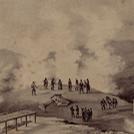The Traveler's Eye and the Environment
The landscape in the aesthetic sense
The idea that it was worth noticing and noting down the features of the natural setting that framed the various sights on the tour cannot always be taken for granted, as one might have expected, in the account of a journey. In some examples, on the contrary, especially from the age of “encyclopedic” travelers, that 18th century in which the fashion of making the journey to Italy became established, we find interminable lists of names and works of art but no mention of the colors of the country's sky and its ever varying scenery. Luckily there were exceptions, and luckily Romanticism brought a new feeling for the landscape which, expressed not just in words but also through many paintings, faithfully reproduced environmental settings in an accurate and even enthusiastic way.
The interest in natural phenomena

The 'locations' interested another type of traveler as well, the sort who, prompted by more or less professional scientific interests, paid attention not to the aesthetic aspect of the landscape but to its constituent components, taking an interest in climatic and agricultural factors, in natural phenomena of various kinds. They too made a considerable contribution to conveying the facies of the territory, which all too often remained in the shadow since many travelers preferred to focus on the creations of humanity rather than on those of nature.